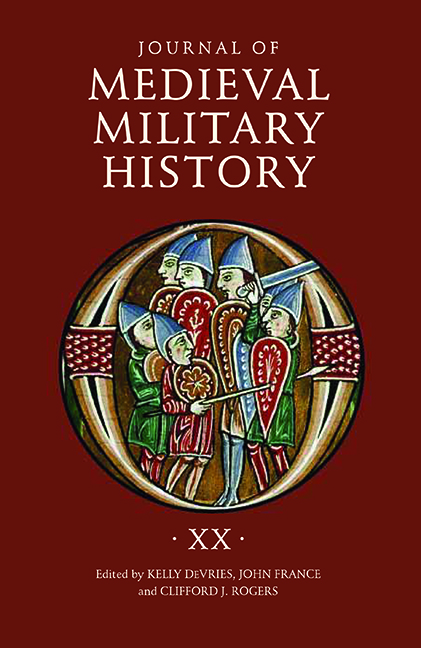Book contents
- Frontmatter
- Contents
- List of Illustrations
- 1 De velitatione bellica and the Georgian Art of War During the Reign of David IV
- 2 The Afterlife of the Medieval Christian Warrior
- 3 More Accurate Than You Think: Re-evaluating Medieval Warfare in Film
- 4 Raising the Medieval Trebuchet: Assembly Method and the Standing of a Half-scale Machine
- 5 Cum Socio Eiusdem: Military Recruitment in the Armies of Edward I Among the Sub-Gentry
- 6 Two Walls of Protection: Queen Elionor of Sicily and Bishop Berenguer de Cruïlles of Gerona During the 1359 Naval Campaigns of The War of the Two Pedros
- 7 The Lancegay and Associated Weapons
- 8 “I intend to give him battle.” Battle-Seeking in a Civil War Context: Toro (1476)
- 9 Discovery of an Early Sixteenth-Century Battle Plan from the Archdiocesan Archive in Ljubljana
- List of Contributors
- Journal of Medieval Military History 1477-545X
7 - The Lancegay and Associated Weapons
Published online by Cambridge University Press: 07 October 2022
- Frontmatter
- Contents
- List of Illustrations
- 1 De velitatione bellica and the Georgian Art of War During the Reign of David IV
- 2 The Afterlife of the Medieval Christian Warrior
- 3 More Accurate Than You Think: Re-evaluating Medieval Warfare in Film
- 4 Raising the Medieval Trebuchet: Assembly Method and the Standing of a Half-scale Machine
- 5 Cum Socio Eiusdem: Military Recruitment in the Armies of Edward I Among the Sub-Gentry
- 6 Two Walls of Protection: Queen Elionor of Sicily and Bishop Berenguer de Cruïlles of Gerona During the 1359 Naval Campaigns of The War of the Two Pedros
- 7 The Lancegay and Associated Weapons
- 8 “I intend to give him battle.” Battle-Seeking in a Civil War Context: Toro (1476)
- 9 Discovery of an Early Sixteenth-Century Battle Plan from the Archdiocesan Archive in Ljubljana
- List of Contributors
- Journal of Medieval Military History 1477-545X
Summary
The light lance or lancegay was one of the most ubiquitous weapons used throughout centuries of warfare in Europe and beyond, from ancient times well into the modern era. This article traces the development of the weapon during the medieval period in its broadest sense, though drawing on its earlier and later manifestations. It offers a detailed analysis of a major category of weapon that has received far less attention than more glamorous but shorter-lived arms such as the heavy war lance and the longbow. It demonstrates that the maneuvers of the light lance and the tactics commonly associated with Napoleonic and later periods were familiar to medieval warriors and outlined in contemporary literature. The lancegay was a flexible and enduring weapon, favored by all classes of society, that could be deployed quickly both on horse and foot. Despite some variation in nomenclature, it is possible to demonstrate how the lancegay was utilized by different groups during and beyond the medieval period. Its carriage and manipulation are examined together with the tactics and riding skills that enabled it to achieve its full potential within a light cavalry role.
As with many weapons from the historical past the lancegay requires considerable explication, not least because of the confusing terminology that surrounds it. Although known by several different designations, the lancegay was essentially the light lance of ancient origin, commonly used throughout the whole of the Middle Ages, which preceded, was used alongside, and finally superseded the more renowned heavy lance. The lancegay reached the height of its popularity during the fifteenth and early sixteenth centuries, being much favoured in the Renaissance. It was succeeded by the light cavalry lance which, largely of a similar design, remained in use well into the early twentieth century. During the Late Middle Ages, the lancegay achieved a social status not dissimilar to that of the sword as well as acquiring a lethal reputation.
David Scott-Macnab has written extensively about the weapon's origin within a linguistic, literary, and political context, noting the complications caused by “false etymologies and speculative interpretations.”
There are, however, many scattered references and much disparate information that have yet to be brought together.
- Type
- Chapter
- Information
- Journal of Medieval Military HistoryVolume XX, pp. 137 - 184Publisher: Boydell & BrewerPrint publication year: 2022

